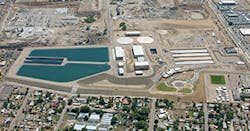Integrating AMI and MDM: A Worthwhile Venture?
As more and more water utilities migrate from automatic meter reading (AMR) technology to Advanced Metering Infrastructure (AMI) technology—or go directly to AMI—the opportunity to also introduce a meter data management (MDM) system presents itself.
Trends
First, though, let’s look at the trends in this area. How common is it for water utilities to integrate AMI and MDM? “More and more water utilities, in the US and globally, are integrating data management into their operational processes to maximize the benefits of AMI,” says Brian Crow, vice president of analytic solutions for Sensus. “Utilities receive endless amounts of information from their infrastructure, but without a solid data management plan, the data is just that—data. In order to truly tap into the power of AMI, utilities must plan to integrate data management into their businesses.”
Joe Ball, Itron’s North America director of marketing for water, agrees. “We absolutely see an increase in the integration of MDM and AMI in the water industry,” he says. “It wasn’t very common in the days of AMR, but it is definitely becoming more common in the AMI days.” Electric utilities have been using MDM for a while, but water utilities don’t have the same requirements for MDM that electric utilities do. However, according to Ball, the value of MDM for water utilities is the ability to create long-term data storage and then access this data for analytics.
Dale Pennington, managing director of Baton Rouge, LA-based Utiliworks Consulting, has found that some larger water utilities, primarily those with 15,000 or 20,000 meters and above, and which also have full-time IT staff, are more likely to introduce full-blown MDM systems with their AMI systems. “These MDM systems are more complex, but in our view, they are absolutely a requirement for these utilities in order for them to properly partition and utilize the data with all of the different AMI applications that exist,” he says. “In fact, we wouldn’t even consider working on an AMI project with a large utility without an MDM system being provided for. You just can’t manage the data without an MDM system.”
What about smaller water utilities? Pennington has found that some smaller water utilities are introducing what he calls an “MDM-lite” system, which doesn’t have all of the details and complexities, but can still provide some useful information.
Problems From Lack of MDM
According to many in the industry, failing to integrate an MDM system with an AMI system can cause problems for water utilities. “If utilities do not integrate data management, they will struggle to realize the business value of their data and AMI deployment,” says Sensus’s Crow. Data management infrastructure supports long-term analytics, real-time operations, and system benchmarking. If this data is not integrated with AMI, the quality of results from these processes is at risk. This makes it difficult for utilities to determine what is important and where they should take action. “By integrating data management, utilities get a holistic view of their businesses and ensure that the data is there for future analysis,” he says.
Itron’s Ball agrees. “Without this integration, AMI systems do not have long-term data storage for the raw data,” he says. “Rather, they interface with the billing system, and this is where the data would end up. As a result, any historical analysis will be based just on billing data.” In sum, according to Ball, the decision not to integrate MDM and AMI really limits the value they could get from AMI.
Benefits of Integrating MDM With AMI
“By integrating AMI and data management, at least with the Itron system, you can put time-synchronized interval data from the AMI system into storage and use it for analytics,” says Ball. This shows the exact time of day that consumption, tampering, or other meter alerts happen. You can then go back and “slice and dice” that data to be able to learn more. “For example, you can identify, in granular detail, when demand for water is highest, and what kinds of customers are driving that demand, which allows you to make better decisions as to when you want to pump more water,” he says. You can also use the information immediately. For example, you can identify a customer-side leak and then make proactive contact with that customer.
Sensus’s smart water network
By integrating MDM and AMI, utilities can realize the full value of their AMI investments, according to Sensus’s Crow, because they have a way to analyze data and act on it. “Ensuring that the data is credible and available to the users when they need it expands the value of their technology investment,” he says. Water utilities that integrate data management with AMI will be able to:
- Improve conservation. Utilities that integrate data management and AMI can make meaningful changes to their conservation efforts by receiving instant alerts about leaks in their systems. In addition, the ability to tap into the longer-term data in order to trend and benchmark allows utilities to measure and quantify their conservation efforts. Less water lost means less energy to clean and transport the water, less chemicals for treatment, and more money saved. “This can especially make an impact in areas that are hard-hitby droughts, such as California,” says Crow.
- Enhance customer service. Information is also key to good customer service. Utilities can provide their customers with a never-before-seen look at their water consumption and alert them to water leaks before they become an issue. This line of communication lets customers know that their utilities are good stewards of their money and natural resources.
- Increase communication. Data management and AMI help water utilities better communicate with other utilities and government counterparts, making the utilities more efficient as a whole. “For example, a water utility can share information about a broken water line with the transportation department, so that traffic can be redirected while the line is being repaired,” says Crow. “Working together and sharing information benefits everyone.”
An aerial view of the drinking water treatment plant in Albuquerque, which uses Sensus’s FlexNet AMI system and MeterSense’s MDM system.
Integration Challenges
While there can be multiple benefits to integrating MDM with AMI, it is not an easy process. “The rate of innovation is not slowing down,” says Sensus’s Crow. “In the future, sensor technology will transmit more data faster, making data management processes a key part of any utility investment. The key challenge for water utilities is to predict what their needs may be down the road, so that they can choose the right technology platform.” It is critical to determine what data elements are important today and for the future, so that data is not lost over time.
According to Utiliworks Consulting’s Pennington, it is much easier for a water utility to implement an MDM system at the same time as it implements an AMI system, because the two systems together really change the way that the utility captures and manages data. As a result, the utility only needs to transition from an old system to a new system once. “If a utility introduces AMI and then adds MDM later on, it requires quite a bit of restructuring and partitioning of the data, which can be quite problematic,” he says.
Keys to Success
If a utility procures its AMI and MDM systems from different vendors, it will be difficult to integrate the two systems. “However, if you procure them from the same vendor, which has existing integrations with the two systems, it makes the implementation a lot easier,” says Itron’s Ball.
“The most important part of a successful integration is not to do it alone,” says Sensus’s Crow. “Select a technology partner who can manage your AMI, data management, and analytics solutions. This will truly maximize the value of your investment.”
Crow also recommends starting slow and small. “Find ways to showcase the value of data management to your business in the short-term,” he says. “Showing meaningful results to your stakeholders will demonstrate why data management is an important step for the future.”
“When we work with water utilities, we will set up the AMI and MDM systems and make sure all of the processes flow properly, and that the education takes place in all of the departments to make sure everyone understands how to utilize the system and understands what the data can do,” says Utiliworks Consulting’s Pennington. “For example, with an MDM system, you can do daily revenue streaming, so that the finance guy knows how much water was sold and how much money they collected that day. The data can then be sent to the guys on the hydraulic modeling team, so they can see what the actual flows were through the pipes compared to what they were engineered for. The data can also be sent to the pressure guys, so they can see what the drawdown effects are, and maybe they can pump at different times of the day in order to save money.” In addition, according to Pennington, if you have customers on “balanced billing,” you can send them a notice if they are using more water than expected. In sum, the integration of AMI and MDM is not just a “meter to cash” process. It is really a “meter to asset management” process.
Due to drought conditions, the San Juan-Chama drinking water plant in New Mexico uses metering technology from Sensus and MeterSense.
But Maybe MDM Is Not For Everyone
While there are a lot of people in the industry who strongly encourage the integration of MDM and AMI, there is at least one company that suggests water utilities take a second look at the concept. “One drawback to implementing an MDM system is that it adds a lot more complexity to an already complex AMI process,” says John Sala, director of marketing for Neptune Technology Group. “In addition, it is extremely expensive to implement.”
Beyond that, according to Sala, the vast majority of water utilities don’t even need MDM systems if they already have good AMI systems in place. “The MDM system is really an information storage location,” he says. “It cannot have any more information related to metering and consumption than the AMI system itself gathers.” That is, MDM is not more than the sum of the AMI parts.
However, agrees Sala, there can be some value-adds from MDM, in that it may add other intelligence that can help to support the AMI data, such as certain accounting information, allowing the opportunity to make more intelligent analysis.
“MDM originally came into existence in the electric utility industry, and the reason it did so is that some large utilities had several different AMI systems, spread out over large numbers of customers and territories,” says Sala. “The MDM system was important for them, because it served as the central clearinghouse for all of the data from the various AMI systems. However, if you only have one AMI system, you may not even need an MDM system, again, because the MDM is not more than the sum of the AMI parts.”
According to Sala, most AMI systems that are in place in water utilities have enough information available on them that MDM systems are not really necessary. For example, good AMI systems already have built-in reporting, general analysis, event analysis, alarming, etc. “In other words, most major AMI systems have a lot of the MDM functions already built into them,” says Sala. “Our AMI system, for example, automatically maintains two years of data, which allows a lot of different types of analyses to be done, such as customer reporting, data analytics, and mapping. As such, in a way, we are already providing a basic MDM system within the AMI system that we offer.”
In addition, according to Sala, it often requires a large IT staff to write the custom programs that allow the MDM system to provide specific information to the AMI. “And even this usually only occurs in large electric utilities and some very large water utilities—those that I define as ‘NFL-size cities,'” he says. “However, it is not common at all for the majority of water utilities.”
To continue reading the full article check out the March/April edition of Water Efficiency, please click here. You may need to log-in or subscribe to our magazine.





